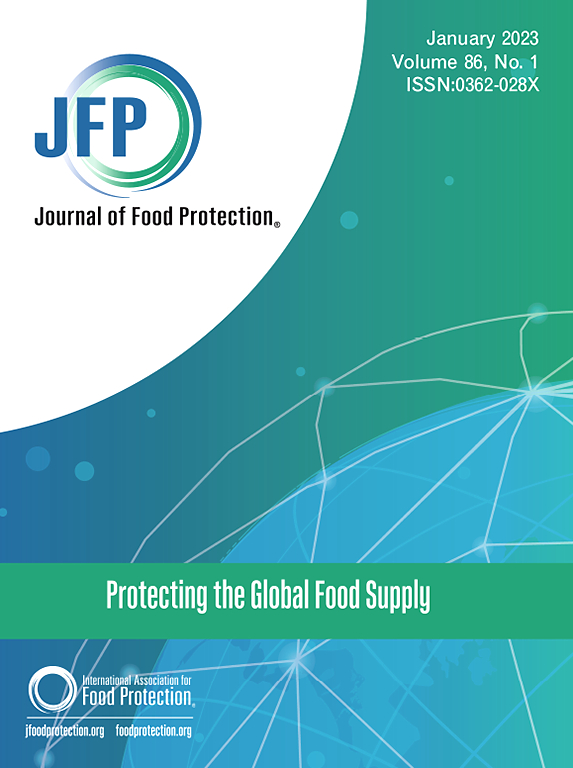沙门氏菌浓度大于或等于 10 CFU/mL 的家禽翅膀冲洗物鉴别方法评估。
IF 2.1
4区 农林科学
Q3 BIOTECHNOLOGY & APPLIED MICROBIOLOGY
引用次数: 0
摘要
在美国,食品安全检验局(FSIS)发布的《减少家禽沙门氏菌病的拟议监管框架》强调,需要采用简单、快速的方法来识别沙门氏菌浓度≥ 10 CFU/mL 的禽类翅膀冲洗样本。在冷藏后的两节禽翅冲洗液(48 只火鸡和 72 只鸡肉)中接种了八种冷应激和营养不良沙门氏菌菌株中的一种,其浓度为 0.22 至 3.79 log CFU/mL,然后用 3 管最可能菌落数 (MPN)、BioMerieux GENE-UP QUANT、Hygiena BAX SalQuant 和新型阈值法进行测定。沙门氏菌的 MPN 定量下限 (LLQ) 为 -0.96 log CFU/mL。MPN 高估了接种的沙门氏菌水平 0.05 ± 0.35 log CFU/mL。GENE-UP QUANT 沙门氏菌检测法(LLQ = 1.00 log CFU/mL)低估了接种沙门氏菌水平 0.05 ± 0.51 log CFU/mL。BAX SalQuant 方法(LLQ = 0.00 log CFU/mL)低估了 1.21 ± 0.78 log CFU/mL 的接种沙门氏菌水平。开发了泊松概率为 0.95 (PiLOT-95)、0.86 (PiLOT-86)、0.63 (PiLOT-63) 和 0.50 (PiLOT-50)的阈值测试方法,以识别沙门氏菌含量≥ 10 CFU 的禽类翅膀漂洗物。MPN 的准确率为 93.1%,可准确确定禽翅冲洗液中沙门氏菌的含量是否≥ 10 CFU/mL,但 MPN 的成本和时间要求可能会让大多数实验室望而却步。GENE-UP 定量的准确率为 86.1%,但 GENE-UP 方法需要设备和专业技术,而一些食品安全实验室可能不具备这些条件。BAX 定量的准确率最低,为 58.4%。PiLOT阈值检测的准确率从PiLOT-50的83.2%到PiLOT-86的93.1%不等。PiLOT 阈值测试非常简单,可用于识别许多含有超过任何用户定义浓度阈值的沙门氏菌的环境或食品样本。本文章由计算机程序翻译,如有差异,请以英文原文为准。
Evaluation of Methods for Identifying Poultry Wing Rinses With Salmonella Concentrations Greater Than or Equal to 10 CFU/mL
In the United States, the Proposed Regulatory Framework to Reduce Salmonella Illnesses Attributable to Poultry published by the Food Safety and Inspection Service (FSIS) has highlighted the need for simple, rapid methods that identify poultry wing rinse samples harboring Salmonella concentrations ≥10 CFU/mL. One of eight cold-stressed and nutrient-starved Salmonella strains was inoculated into post-chill two-joint poultry wing rinses (48 turkey and 72 chicken) at levels from 0.22 to 3.79 log CFU/mL, and then measured by 3-tube Most Probable Number (MPN), BioMerieux GENE-UP QUANT, Hygiena BAX SalQuant, and novel threshold methods. The MPN lower limit of quantification (LLQ) for Salmonella was −0.96 log CFU/mL. MPN overestimated the inoculated Salmonella level by 0.05 ± 0.35 log CFU/mL. The GENE-UP QUANT Salmonella method (LLQ = 1.00 log CFU/mL) underestimated the inoculated Salmonella level by 0.05 ± 0.51 log CFU/mL. The BAX SalQuant method (LLQ = 0.00 log CFU/mL) underestimated the inoculated Salmonella level by 1.21 ± 0.78 log CFU/mL. Threshold test methods with Poisson probabilities of 0.95 (PiLOT-95), 0.86 (PiLOT-86), 0.63 (PiLOT-63), and 0.50 (PiLOT-50) were developed to identify poultry wing rinses harboring Salmonella levels ≥10 CFU. MPN was 93.1%, accurate for determining if Salmonella levels in poultry wing rinses were ≥10 CFU/mL, but MPN costs and time requirements can be prohibitive for most laboratories. GENE-UP quantification was 86.1% accurate, but the GENE-UP method requires equipment and technical expertise that some food safety laboratories may not possess. BAX quantification had the lowest accuracy; 58.4%. PiLOT threshold test accuracies ranged from 83.2% for PiLOT-50 to 93.1% for PiLOT-86. The PiLOT threshold tests are simple and can be adapted to identify many environmental or food samples containing Salmonella exceeding any user-defined concentration threshold.
求助全文
通过发布文献求助,成功后即可免费获取论文全文。
去求助
来源期刊

Journal of food protection
工程技术-生物工程与应用微生物
CiteScore
4.20
自引率
5.00%
发文量
296
审稿时长
2.5 months
期刊介绍:
The Journal of Food Protection® (JFP) is an international, monthly scientific journal in the English language published by the International Association for Food Protection (IAFP). JFP publishes research and review articles on all aspects of food protection and safety. Major emphases of JFP are placed on studies dealing with:
Tracking, detecting (including traditional, molecular, and real-time), inactivating, and controlling food-related hazards, including microorganisms (including antibiotic resistance), microbial (mycotoxins, seafood toxins) and non-microbial toxins (heavy metals, pesticides, veterinary drug residues, migrants from food packaging, and processing contaminants), allergens and pests (insects, rodents) in human food, pet food and animal feed throughout the food chain;
Microbiological food quality and traditional/novel methods to assay microbiological food quality;
Prevention of food-related hazards and food spoilage through food preservatives and thermal/non-thermal processes, including process validation;
Food fermentations and food-related probiotics;
Safe food handling practices during pre-harvest, harvest, post-harvest, distribution and consumption, including food safety education for retailers, foodservice, and consumers;
Risk assessments for food-related hazards;
Economic impact of food-related hazards, foodborne illness, food loss, food spoilage, and adulterated foods;
Food fraud, food authentication, food defense, and foodborne disease outbreak investigations.
 求助内容:
求助内容: 应助结果提醒方式:
应助结果提醒方式:


